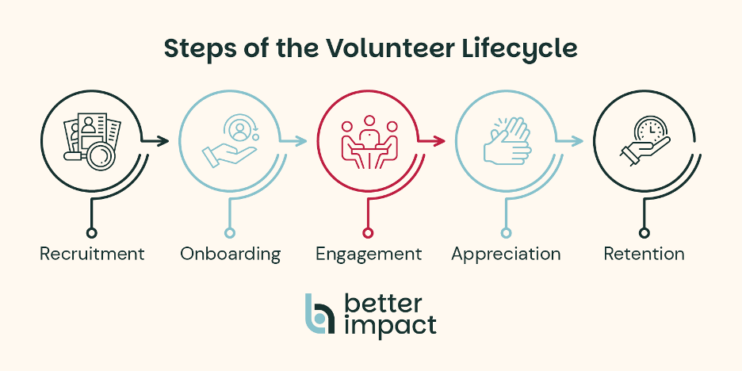Volunteer Management 101: How to Create a Strong Strategy

If you’ve worked in the nonprofit sector for some time, you likely know that effective donor management is essential to your organization’s success. When you carefully track donor relationships and use data to choose your next steps for cultivating each individual supporter, you can make more successful fundraising asks that yield the revenue you need to fund all of your programs and operations.
However, donors aren’t the only group your team needs to manage to maximize your impact. Volunteers are also critical to many organizations’ success, and therefore, they require a strategic management approach that motivates them to continue doing their best work for your mission.
Whether you’re new to volunteer management or looking for a refresher on the basics to help you improve your existing strategy, you’ve come to the right place! In this guide, we’ll discuss a few practical tips for managing volunteers effectively so you can build a thriving volunteer program.
Understand the Volunteer Management Lifecycle
The volunteer management lifecycle is similar to the donor lifecycle or donor journey in some ways. It’s a tool that tracks volunteers’ involvement with your organization from first contact to long-term commitment. However, because volunteers give their time and skills instead of money, there are some unique considerations you’ll need to remember as you work to optimize their journey.
Here is an overview of the five steps of the volunteer lifecycle:

- Recruitment. While this stage involves attracting volunteers to your organization at its most basic level, recruiting the right talent for the roles you want to fill is also critical. To accomplish this, you’ll need to write clear role descriptions and create streamlined applications to promote across your marketing channels. Keep in mind that some volunteer roles may require additional vetting like interviews and background checks, too.
- Onboarding. This step ensures new volunteers fully understand their positions before they get started. Educate volunteers on your organization’s values and culture, key policies and procedures, and role-specific training needs (e.g., how to sort canned goods at a food bank or walk rescue dogs at an animal shelter). Depending on your program structure, you might onboard volunteers via live training sessions, independent online courses, shadowing opportunities, or a mix of these methods.
- Engagement. Volunteer engagement encompasses everything you do after onboarding to keep volunteers active, informed, and motivated to contribute. Tactics here range from establishing regular communication cadences and allowing flexibility in scheduling to providing ongoing training resources and encouraging volunteers to tap into their employers’ volunteer programs (volunteer grants, volunteer time off, etc.)
- Appreciation. Naturally, at this stage, you let volunteers know how grateful you are for their service to your organization. While you’ll likely focus on formal recognition methods like writing thank-you cards, hosting appreciation events, and giving out awards as you develop your strategy, don’t underestimate the value of informal expressions of gratitude. A quick, verbal “Thanks for your help!” or “Great work today!” from a supervisor at the end of a shift can keep volunteers motivated between more official instances of recognition.
- Retention. Retaining volunteers allows your program to thrive long-term. It’s less time- and resource-intensive than constantly recruiting new volunteers, and it builds a loyal, reliable support base for your mission. Appreciation is the first step to retention, and from there, make sure to regularly check in with your volunteers, gather and implement feedback, and provide advancement opportunities to encourage them to stick around.
Volunteer management software will be your best friend throughout this entire process. The right platform will help you track where every volunteer is in their journey and design tactics to successfully move them to the next stage of the lifecycle.
Track Key Volunteering Metrics
Your volunteer management solution is also important for collecting and analyzing data on your entire program. The best software comes with configurable dashboards, robust reporting tools, and secure storage so you can track volunteer data in one place and gain actionable insights from it.
To make the most of your volunteer data, set up your platform to track essential program metrics like your:
- Total active volunteers. In addition to providing a snapshot of your program’s size and reach, this data point can help you identify lapsed volunteers (i.e., individuals who previously volunteered with your organization but haven’t engaged in the past 6-12 months) so you can reach back out to them.
- Total volunteer hours. When you quantify the time volunteers have invested in your organization as a whole and into specific work areas (community-facing initiatives, fundraising events, etc.), you can more effectively demonstrate the value of your volunteer program to stakeholders.
- Volunteer retention rate. This metric shows how many volunteers return to your organization from year to year or event to event, giving you a starting point for determining if volunteers are staying loyal to your organization and why or why not.
- Interactions with your volunteer program communications. This category encompasses a variety of marketing metrics, from email and text message open rates to social media post interactions and traffic to the volunteer-focused pages of your organization’s website. Monitoring these data points lets you know which communication channels current and prospective volunteers prefer, so you can concentrate on creating engaging content for them.
- Volunteer satisfaction. Satisfaction data can be quantitative (collected through multiple-choice survey questions) or qualitative (gathered from open-ended survey responses, interviews, informal conversations, and reviews of your volunteer program). Both types show what aspects of your program volunteers are happiest with and where they see room for improvement.
Since each of these metrics adds a different value to your volunteer management strategy, consider your needs and goals as you choose which data points to prioritize for tracking and analyzing.
Promote Volunteer Management Training at Your Organization
Professional development is important for improving all areas of nonprofit management, especially volunteer coordination. The volunteer landscape is constantly changing, so if your volunteer management team takes advantage of ongoing training opportunities, it will help your program adapt to the times and continue to thrive.
According to Better Impact’s volunteer management training guide, these opportunities typically take one of the following five forms:
- Certifications: Comprehensive, standardized learning opportunities offered by recognized authorities in the volunteer space
- Certificates: Shorter educational programs that focus on specific skills or knowledge areas, which can be offered by volunteer management organizations or universities
- Conferences: In-person or virtual gatherings of volunteer management professionals that include multiple educational sessions and networking opportunities, often over several days
- Webinars and panels: Digital information sessions involving one (webinar) or a few (panel) experts who speak and answer audience questions on a volunteer-related topic
- Blogs and newsletters: Frequently updated, usually free online resources that often provide information about recent volunteer management developments
To decide which training options are best for you, consider your educational goals, budget, and preferred learning style (guided vs. independent, in-person vs. online, etc.). While there is no one-size-fits-all approach to improving volunteer management skills, any continuous learning you tap into will benefit you, the rest of your team, and your volunteers!
A thoughtful approach to volunteer management deepens relationships, increases impact, and builds long-term community support—while also streamlining volunteer-related operations. With the tips above and the right tools on your side, you’ll be well on your way to developing or improving a strategy that allows your program (and mission-driven efforts!) to thrive.

